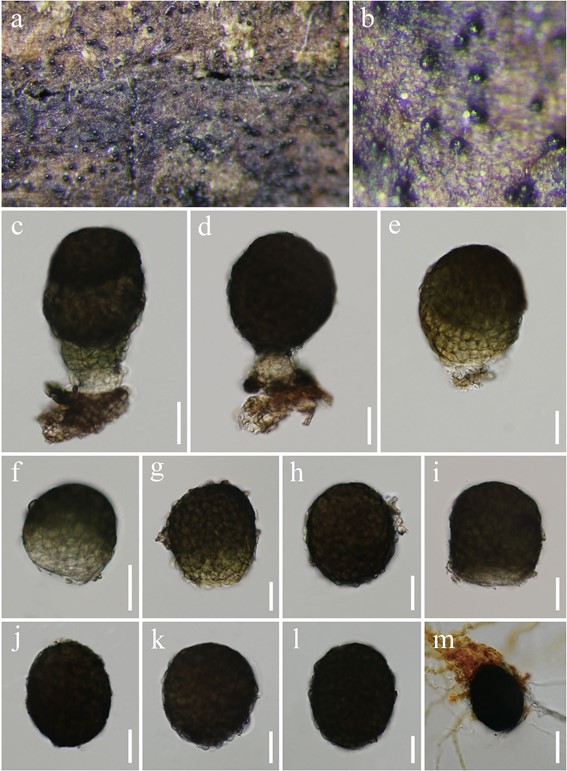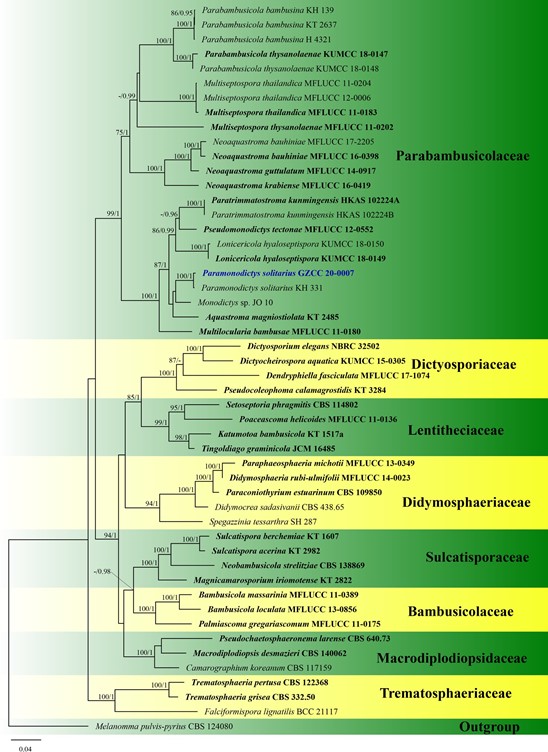Paramonodictys solitarius N.G. Liu, K.D. Hyde & J.K. Liu, sp. nov.
MycoBank number: MB 557093; Index Fungorum number: IF 557093; Facesoffungi number: FoF 06710; Fig. 58
Etymology: Name reflects the solitary conidia.
Holotype: MFLU 19-2854
Saprobic on decaying wood. Sexual morph: Undetermined. Asexual morph: Hyphomycetous. Colonies on natural substrate superficial, effuse, scattered, solitary, black. Mycelium partly immersed, partly superficial, com- posed of brown, branched, septate hyphae. Stroma present, erumpent, erect, subcylindrical or truncated-cone-form, pale brown to olivaceous brown, up to 20 μm high. Conidiophores absent. Conidiogenous cells monoblastic. Conidia 50–87 × 40–61 μm ( x̄ = 64 × 52 μm, n = 30), solitary, dictyosporous, muriform, globose or subglobose, olivaceous brown to dark brown, broadly rounded at apex, sometimes subtruncate at base.
Culture characteristics: Conidia germinating on water agar within 24 h. Germ tubes produced peripherally. Mycelia superficial, irregularly circular, with entire edge, greyish white from above, dark brown at centre, pale brown at circumference from below.
Material examined: CHINA, Guizhou Province, Guiyang, Guizhou Academy of Agricultural Sciences, on decaying wood, 27 August 2018, N.G. Liu, NKY036 (MFLU 19-2854,
holotype), ex-type living culture, GZCC 20-0007.
GenBank numbers: ITS =MN901152, LSU =MN897835, SSU = MN901118, RPB2 = MT023015, TEF1-α= MT023012.
Notes: Tanaka et al. (2015) provided sequence data for an unnamed Monodictys species without any morphological information. However, molecular comparison indicated our collection and their strain are the same species (Fig. 59). Paramonodictys solitarius, characterised by absence of conidiophores, differs from Pseudomonodictys tectonae Doilom et al. The latter has semi-macronematous to sometimes macronematous conidiophores. Moreover, the conidia of P. solitarius are produced directly from stroma.

Fig. 58 Paramonodictys solitarius (MFLU 19-2854, holotype). a, b Colonies on natural substrate. c, d Conidia on stromata. e–l Conidia. M Germinated conidium. Scale bars: c–l = 20 μm, m = 30 μm

Fig. 59 Phylogram generated from maximum likelihood analysis based on combined LSU, ITS, SSU, TEF1-α and RPB2 sequence data representing Parabambusicolaceae and the closely related families in Pleosporales. Fifty strains are included in the combined analyses which comprise 4416 characters (872 characters for LSU, 543 char- acters for ITS, 1034 characters for SSU, 922 characters for TEF1-α, 1045 characters for RPB2) after alignment. Melanomma pulvispyrius (CBS 124080) in Melanommataceae (Pleosporales) is used as the outgroup taxon. Single gene analyses were also performed to compare the topology and clade stability with combined gene analyses. Tree topology of the maximum likelihood analysis is similar to the Bayesian analysis. The best RAxML tree with a final likelihood values of − 28950.933465 is presented. The matrix had 1788 dis- tinct alignment patterns, with 32.59% undetermined characters or gaps. Estimated base frequencies were as follows: A = 0.240257, C = 0.252649, G = 0.271819, T = 0.235275; substitution rates AC = 1.353719, AG = 3.137124, AT = 1.266860, CG = 1.010760, CT = 6.055808, GT = 1.000000; gamma distribution shape parameter α = 0.189550. Bootstrap values for maximum likelihood (ML) equal to or greater than 75% and clade credibility values greater than 0.95 from Bayesian-inference analysis labeled on the nodes. The ex-type and ex-epitype strains are indicated in bold. The new isolate is indicated in bold and blue
